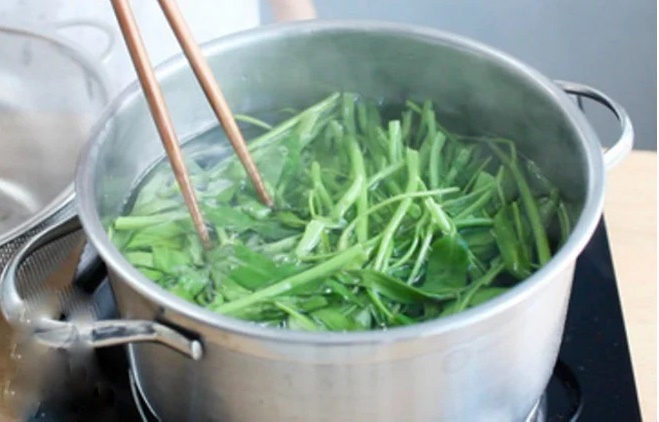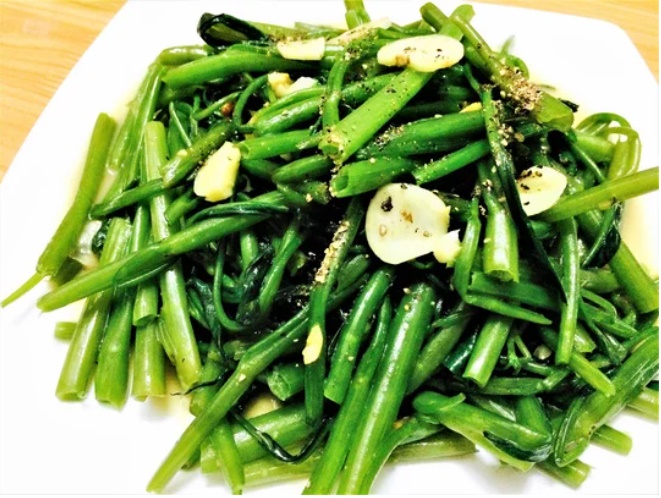Choosing the Best Vegetables: To ensure your vegetables stay crisp and vibrant, it’s important to select fresh, preferably just-picked greens.
Remember, fresh vegetables are at their most flavorful, crisp, nutritious, and vibrant when stir-fried.
Opting for wilted greens will result in a less-than-crisp dish, and the color of the vegetables will dull and darken during cooking.
Preparing the Vegetables: Once you’ve selected the perfect vegetables, it’s time to clean and soak them. Soaking vegetables in salted water helps prevent oxidation and minimizes nutrient loss, including trace elements. Greens are rich in chlorophyll, which can turn dark if oxidized.

Blanching the Vegetables: Before you stir-fry, it’s important to blanch your greens. Many green vegetables contain oxalic acid, so blanching is a necessary step before consumption. Bring a pot of water to a boil, add a pinch of salt, and then add the greens directly to the boiling water. Blanch for 20 seconds and then remove them promptly—over-blanching leads to vitamin loss.
Stir-Frying: The golden rule of stir-frying vegetables is to do it for three minutes over high heat.
Heat your wok or pan over the highest heat setting. To test if it’s hot enough, sprinkle a few drops of water into the pan; if the water evaporates within one to two seconds of contact, your pan is ready. Be careful not to overheat the pan.
Remove the pan from the heat and add oil: Take the pan off the heat and add a spoonful of oil. Lift the pan and tilt it to coat the bottom and sides (if the oil smokes excessively when added, it’s too hot. Remove from the heat and let it cool for a few minutes).
Add garlic and chili (if using) and sauté for 10 seconds or until fragrant.

Add vegetables: Push the garlic to the side of the pan and add your greens.
Season the vegetables: Sprinkle with salt and pepper.
Stir-fry for one minute: Stir-fry for approximately one minute or until the vegetables start to wilt.
Add the sauce: Pour the sauce around the edges of the pan, not directly into the center (this prevents cooling the pan and reducing the cooking temperature). Stir and toss the vegetables to coat them in the sauce.
Stir-fry only a handful of vegetables at a time, relative to the size of your pan. Overcrowding the pan makes it difficult to stir evenly, resulting in uneven cooking and discoloration.
Source: Khoevadep
Is It Okay to Use Meat Broth for Boiling Vegetables?
“Should You Use Meat Broth to Boil Vegetables?”
There’s a constant debate on whether it’s a good idea to use meat broth for boiling vegetables. While some advocate for this method as a time-saver that preserves nutrients, others question the potential impact on taste and health. So, what’s the verdict? Is it a convenient, nutritious option, or does it compromise the integrity of your veggies?
Stir-Frying Vegetables: A Colorful and Delicious Feast”’>“The Ultimate Guide to Stir-Frying Vegetables: A Colorful and Delicious Feast”
Are you tired of overcooked, bland, and unappealing stir-fried vegetables? It’s time to elevate your vegetable game! With our expert tips and tricks, you can master the art of stir-frying and create dishes that are not only delicious but also visually appealing. Imagine serving up a plate of vibrant, perfectly cooked vegetables that will have your family and friends asking for seconds. Learn from us, and your stir-fried vegetables will always be the star of the meal!




































